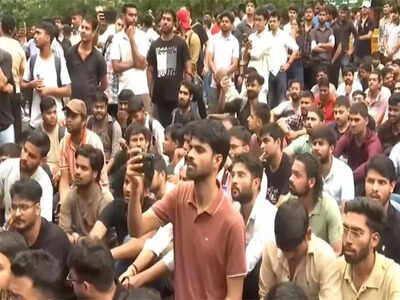US may lose 150,000 international students this fall: Here’s why global talent is pulling back

The United States could see its international student population decline by as many as 150,000 this fall, according to an alarming new projection from NAFSA: Association of International Educators, as reported by Forbes. For a nation that has long marketed itself as the global hub of higher education, this signals not just a temporary visa backlog—but a potentially lasting shift in how international students view the American academic promise.
A troubling reversal after record highs
Just last year, US colleges and universities hit a historic milestone with 1,126,690 international students enrolled during the 2023–24 academic year, per the Institute of International Education’s Open Doors report. That figure marked a post-pandemic rebound and represented about 6% of the total US college student population. It also included those on Optional Practical Training (OPT), a work authorisation program that allows international students to remain in the US for up to a year after graduation.But the momentum is already faltering. Based on new data from the Student and Exchange Visitor Information System (SEVIS) and recent US State Department trends, NAFSA now warns that unless visa issuance rebounds sharply, the country could experience a significant pullback in international enrolment. The estimate, compiled in conjunction with JB International, suggests a 30–40% decline in new foreign student arrivals, which would translate to a 15% drop overall.
What’s driving the decline?
NAFSA’s report identifies a perfect storm of bureaucratic, political, and administrative hurdles that have disrupted the student visa pipeline at the worst possible time, right before the start of the fall 2025 semester.First, there was the temporary suspension of visa interviews between May 27 and June 18, a period that traditionally sees the highest volume of student visa activity. Though interviews later resumed, the delays were compounded by a new directive requiring consular officers to closely scrutinise applicants’ social media activity, adding to processing times and uncertainty.Second, the availability of visa appointments remains limited or non-existent in several key countries, including India, China, Nigeria, and Japan—four of the top 15 countries sending students to the US India and China together alone account for the lion’s share of international student traffic.Adding to the concern is a sharp dip in visa issuance rates. F-1 visa approvals were down 12% from January to April 2025, and dropped a further 22% in May, compared to the same period in 2024. June data is not yet public, but the NAFSA report warns of a potential 80–90% plunge in approvals for that month.To top it off, a presidential executive order issued on June 4, 2025 imposed visa restrictions on nationals from 19 countries, with reports that as many as 36 more could be added. Though described as security measures, these sweeping bans are casting a wide net over student mobility.
The economic fallout: A $7 billion blow
The decline in student arrivals isn’t just a cultural or academic loss—it comes with massive economic consequences. As Forbes notes, international students contribute significantly to the US economy by paying full tuition (often without scholarships), renting housing, and spending on daily living expenses.NAFSA estimates that a 15% drop in enrolment would lead to a loss of nearly $7 billion in revenue and over 60,000 job losses across the higher education and service sectors.States with large international student populations stand to lose the most:
- California: Projected loss exceeding $1 billion
- New York: Close to $1 billion
- Texas, Massachusetts, Illinois, Florida, Michigan, Ohio, Pennsylvania: Losses upwards of $200 million each
These figures reflect not just tuition but also spending on accommodation, transportation, and community businesses that depend on student populations.
A chilling effect from Trump-era policies
The current crisis also reflects the re-emergence of Trump-era immigration rhetoric and policy enforcement, now revived under the administration’s second term. From tightening visa processes to promoting public narratives that international students are “abusing hospitality,” the message being received abroad is hardly welcoming.Forbes highlights several examples of how federal actions have rattled the higher education sector. One of the most high-profile was the administration’s attempt to block Harvard University from enrolling foreign students—an act that was later halted by court intervention, but not before fuelling fear and confusion among global applicants.The Department of Homeland Security (DHS) has also threatened to revoke the legal status of international students en masse, while Secretary of State Marco Rubio has called for the deportation of students engaged in what he labeled “un-American activities.” Meanwhile, Joseph Edlow, Trump’s pick to head USCitizenship and Immigration Services, told Congress he supports eliminating OPT—a program many universities and tech companies view as essential to retaining global talent.
Can anything be done?
In response to the grim projections, NAFSA has urged the USState Department to act quickly. Their recommendations include:
- Expediting all F-1, M-1, and J-1 student visa appointments and processing
- Exempting students and exchange visitors from the travel bans, while still applying background checks and vetting
Speaking to the broader implications, Fanta Aw, executive director and CEO of NAFSA, told Forbes that the enrolment crisis is “just the tip of the iceberg.”
What this means for Indian students
For thousands of Indian students planning to join US universities this fall, these developments raise serious concerns. Many are facing uncertain visa timelines, missed deadlines, and pressure to defer admissions or choose other countries altogether. Institutions in Canada, the UK, and Australia, already known for smoother visa processes and more welcoming policies, may emerge as the winners in this global talent tug-of-war.Ultimately, the US still offers world-class education. But the country’s ability to retain its reputation as the top global study destination may now depend less on academic rankings and more on policy choices made in the next few months. TOI Education is on WhatsApp now. Follow us here.





